For English version click on “BEITRAG LESEN/READ THE POST” and then scroll to bottom
Wir verlassen Guatemala Stadt und fahren nach Chichicastenango. Die Fahrerei ist teilweise recht anstrengend, da die Straße oft in schlechtem Zustand ist. Bei Chimaltenango geht es nur zähfließend voran und auf der CA1 sind neben den chromglänzenden Bussen immer wieder Radfahrergruppen mit Begleitfahrzeugen unterwegs, die das Überholen erschweren. Entlang der Straße sehen wir eine abwechslungsreiche Mischung aus Ziegeleien, Autowerkstätten, Töpfereien, Webereien und Geschäften mit Holzarbeiten, Obst, Gemüse und Blumen. Die letzten 18 km sind extrem kurvig und es geht bergauf und bergab. In Chichicastenango sind die Straßen sehr eng und zum Teil gesperrt. Wir kommen aber trotzdem durch und treffen Herma und Manni am Football Field. Morgens gehen wir im Cafe „Chichi“ bei Maria frühstücken und dann geht es auf den bekannten Markt. Es fällt mir schwer, meine Eindrücke zu beschreiben. Es herrscht ein reges Treiben und ist voll, eng und bunt. Alles Mögliche wird zum Verkauf angeboten. Selbst auf der Treppe zur Kirche sitzen noch Händler. Es fällt auf, dass hier fast alle Frauen und Mädchen in bunte Trachten gekleidet sind. Das gibt dem Markt nochmal ein gewisses Etwas. Wir stärken uns in einem Cafe und laufen noch raus zum Friedhof. Auch hier fällt der kulturelle Unterschied zu Europa auf. Die Gräber sind ganz anders angelegt als bei uns und es werden größere Treffen abgehalten. Nach einem gemeinsamen Abendessen gehen wir früh ins Bett. Wir müssen die kurvige Strecke wieder zurück, denn wir wollen heute bis Panajachel am Lago Atitlan fahren. An einem Ausblickpunkt halten wir an und haben einen tollen Blick auf Vulkane und Seen. Allerdings müssen wir dann eine steile Abfahrt runter in den Ort. Am Fluß in Panajachel finden wir Stellplätze, laufen noch etwas durch den Ort und erledigen ein paar Einkäufe. Vom Auto aus können wir arbeitende Männer im Flußbett beobachten. Sie machen mit einfachen Werkzeugen Sand und ab und zu fahren Trucks vorbei und sammeln ein, was fertig ist; eine mühsame Arbeit. Am Morgen wollen wir in eine Galerie, die leider geschlossen ist. Wir entscheiden uns dann für das Cultural Center Casa Cahchiequel. Hier sind hauptsächlich Fotos aus den 40er Jahren ausgestellt. Dann kommen wir in die Ecke mit den ganzen Souvenirhändlern und finden natürlich auch ein Andenken für uns. Zurück am Platz ist Faulenzen angesagt. Ralph geht auf Motivsuche am Fluß und beobachtet auch Fischer, die ihre Netze auswerfen. Herma und ich gehen nochmal auf den Markt. Heute machen wir einen Bootsausflug nach San Pedro La Laguna. Der Ort ist jedoch sehr touristisch. Nach einem kurzen Spaziergang über den Markt, nehmen wir zu viert ein Tuc Tuc nach San Juan La Laguna. Der Fahrer setzt uns direkt am Webereimuseum ab. Hier nehmen wir an einer sehr interessanten Vorführung teil. Eine junge Frau zeigt, wie Wolle gesponnen, gefärbt (alles mit natürlichen Farbstoffen) und anschließend gewebt wird. Wenn die Frauen einen Kurs erfolgreich absolviert haben, bekommen sie einen Webstuhl geschenkt und können so etwas Geld verdienen. Für ein großes Tuch brauchen sie bis zu 4 Wochen. Natürlich kann man die Tücher oder andere Objekte kaufen. Zu jedem Teil gibt es ein Zertifikat, wer es gewebt hat, welche Mittel für die Farbe benutzt wurden und wie lange die Frau daran gearbeitet hat. Wir laufen noch durch den Ort, der von Webereien dominiert wird und schöne Wandmalereien hat, bevor es mit dem Boot wieder zurück nach Panajachel geht. Eigentlich ist unsere nächste Etappe nach Antigua nicht sehr weit, aber es geht direkt mit einer Umleitung los, da ein Teil der Straße verschüttet ist. Die neue Strecke führt uns steil hoch bis auf knapp 2.500 Meter. Unterwegs sehen wir wieder viele Menschen, die mit einfachen Mitteln Felder bearbeiten oder Sand gewinnen. Bei Antigua steuern wir als erstes die Finca Asotea an, wo man auch ein Kaffeeplantage besichtigen kann. Allerdings sind wir zu spät und können nicht dort stehen bleiben. Auf Umwegen gelangen wir dann auf den Parkplatz der Policia Touristica. Hier dürfen wir 5 Nächte bleiben und der Platz liegt fußläufig zum Zentrum. Wir beschließen den Tag mit einem kurzen Spaziergang und Erkundung der Stadt. Am Morgen steht als Erstes die Wäscherei auf dem Programm. Nachmittags nehmen wir uns ein Tuc Tuc zur Finca Azotea. Der Eintritt beinhaltet eine Führung durch den Park, das Kaffeemuseum, die Kaffeeplantage und das Musikmuseum. Vor allem das Kaffeemuseum ist sehr interessant. Den Abschluss bildet eine Kaffeeverkostung im Shop und dann fahren wir wieder zurück zum Platz. Am nächsten Morgen haben wir eine geführte Tour bzw. Vulkanwanderung gebucht. Wir stehen um 4:45h auf und sind wie vereinbart um 6:00h am Büro des Veranstalters. Allerdings sind wir da alleine. Gegen 6:25h findet Herma eine Schelle und ein völlig hilfloser junger Angestellter schaut uns erstaunt an. Nachdem wir erklärt haben, dass wir die Tour gebucht haben, telefoniert er eine Weile rum und sagt uns dann, dass wir warten sollen. Um 7:45h kommt dann endlich der Tourbus und um 8:20h geht es los. Nach einer unbequemen Fahrt werden wir am Ziel noch schnell auf die Toilette geschickt und dann starten wir. Auf ca. 1 km machen wir 400 Meter Höhenunterschied. Der Weg ist teilweise sehr steinig und uneben und teilweise sandig und locker. Herma, Manni und Ralph steigen unterwegs um auf die uns begleitenden Pferde. Ich quäle mich bis zum Aussichtspunkt. Wir dürfen nicht weiter hoch, obwohl wir andere Gruppen am Hang sehen. Nach einer kurzen Pause, laufen wir dann alle wieder zu Fuß abwärts. Unterwegs halten wir noch kurz um Marshmallows an einer heißen Quelle zu grillen. Insgesamt ist der Rundwanderweg nur 2,8 km lang aber wir brauchen drei Stunden dafür. Gegen 13:00h sind wir zurück am Platz. Um WiFi zu bekommen, laufen wir nochmal in die Stadt und prompt fängt es an zu regnen. Da wir nicht sicher sind, ob wir das Dachfenster zu haben, laufen wir durch den Regen zurück. Am Stellplatz sind wir nass bis auf die Unterhosen. Den nächste Tag dient der Erholung. Wir quatschen mit Anette und Ralf, die am Vortag auch eingetroffen sind, erledigen ein bisschen Hausarbeit und laufen mit Herma nochmal in die Stadt. Manni fühlt sich nicht so wohl und bleibt am Platz. Am Morgen trennen sich unsere Wege mal wieder. Ralph und ich fahren weiter. Unsere Strecke führt uns wieder über kleine, enge, kurvige Straßen. An einer Stelle steht ein Schild, dass die Strasse für LKWs gesperrt ist. Da wir schon ein Mal im Kreis gefahren sind, biegt Ralph trotzdem ab. Es wird mal wieder richtig steil doch Albatros kämpft sich tapfer den Berg hoch bis wir die CA1 erreichen; umdrehen war auch keine Option. Um kurz vor 16:00h erreichen wir das Restaurant Los Kaskadas. Da wir dort abendessen, dürfen wir auf dem Parkplatz übernachten. Kurz nach 10:00h sind wir an der Grenze zu El Salvador. Zum ersten Mal wollen die Grenzbeamte auch Originalpapiere sehen. Ursprünglich haben wir eine Kopie der Zulassung II abgegeben. Da wir nur das Original der Zulassung I mithaben, gibt es natürlich etwas Erklärungsbedarf. Gegen 13:30h sind wir dann aber durch. Lediglich über die Geldwechsler habe ich mich geärgert. Es ist klar, dass sie nicht den selben Kurs wie die Bank geben, aber 15% Unterschied sind mir doch zu viel. Dann kommt einer, nennt mir einen Kurs und rechnet mir auf dem Taschenrechner vor, wie viel Geld ich bekommen. Ich lehne dankend ab und erst später wird mir bewusst, dass auch der Taschenrechner manipuliert war. Was er mir geben wollte entsprach noch nicht einmal dem (schlechten) Kurs, den er mir angeboten hatte. Weiter geht es jetzt in El Salvador.
English Version (no translation of German text)
We leave Guatemala City and drive towards Chichicastenango. The drive is pretty exhausting since the roads are in bad shape most of the time. Close to Chimaltenango we get stuck and on top of the buses there are a lot of bikers with accompanying cars on CA1 and it is difficult to overtake. Along the road we see a wide variety of different trades and arts such as brick yards, garages, potteries, weaving shops, wooden art and fruits, vegetables and flowers. The last 18 kms are extremely winding with permanent ups and downs. In Chichicastenango the streets are very narrow and partly closed. However, we manage to get to the Soccer Field where Herma and Manni are already waiting. In the morning we first enjoy a nice breakfast at Maria’s café „Chichi“ across the street and then we explore the famous market. It is difficult to describe the impressions from there. The streets are narrow and there are a lot of people and everything is colorful. There probably isn’t much that you can’t buy here. Even the stairs leading to the church are used by the vendors. Most of the woman and girls are dressed in colorful traditional clothes, which add a little extra to the whole picture. We stop at a café and then walk to the cemetery. Again you can see the cultural difference to Europe. The individual graves are totally different and people have gatherings on the sites. After a shared diner we go to bed early. Our destination for today is Panajachel at Lago Atitlan. Therefore we have to drive back the curvy part of the road. We stop at a view point and have a great view of the volcanoes and lakes. However, we then have to take a very steep road down to the town. We find a place besides the river in Panajachel and take a first stroll through town and do some shopping. We can see men work in the river bed. With simple tools they wash sand and every now and then we see the trucks passing by and gathering the sand; a strenuous job. In the morning we wanted to visit a gallery but unfortunately it is closed and we decide to go to the Cultural Center Casa Cahchiequel where the main display is photos from the 1940th. Then we come to the market with the souvenir vendors and of course we find something to buy. Back at the car we just take it slowly. Ralph takes the camera to watch the men at work in the river bed and fishermen throwing their nets. Herma and I go to the market again. The next morning we take a boat to San Pedro La Laguna, a very touristy little town. After a short stroll through the market we take a Tuc Tuc to San Juan La Laguna. The driver drops us off directly in front of the weaver museum. We participate in a demonstration. A young native woman demonstrates the whole process from making wool, coloring it (with natural ingredients only) and weaving a shawl. Native women are trained in the process and once they finish their class, they receive a telar and can earn some money. A big shawl takes them up to 4 weeks. Of course they are for sale in the shop. Each article has a certificate, explaining who the weaver was, what ingredients were used for the color and how long it took to weave. Before we go back to the boat ramp, we stroll through the town, which is dominated by weaving shops and articles and has some nice murals. In theory our next stage isn’t very far but it already starts with a deviation since part of the road is blocked by a landslide. The road is steep and brings us to an elevation of 8,200 ft. Again we see a lot of people who do field work with simple tools. In Antigua our first stop is at Finca Asotea, where you can visit a coffee plantation but we are too late and we can’t stay there for the night. With a bit back and forth we manage to find the parking at Policia Touristica where we can stay a maximum of 5 nights and which is in walking distance to the city center. We go for a short walk and explore the city center. In the morning laundry is our first priority. In the afternoon we take a Tuc Tuc to Finca Azotea. The entrance fee includes the park, the coffee museum, the coffee plantation and a music instrument museum. Most of all the coffee museum is very interesting. We end the visit with a coffee tasting in the shop and then get back to our car. For the next morning we booked a guided volcano tour. Therefore we get up at 4:45 am and are at the tour office at 5 am as instructed. However, there is nobody else. At 6:25 am Herma sees a ring and a totally helpless employee is looking at us with big eyes. After we explained that we booked the tour and where told to be at this place at 6:00 am he starts some phone calls and then explains that we need to wait. At 7:45 am the tour bus arrives and at 8:20 am we finally start the tour. After an uncomfortable trip we just have time to use the rest rooms and then the guide starts the hike. Over roughly 3,300 ft we have to climb an elevation of approx. 1,300 ft. Worst is, that the trail is partly very stony and uneven and partly sandy. Herma, Manni and Ralph switch onto horses along the trail but I make it all the way to the view point. Although we can see some groups climbing the volcano, we are not allowed to continue further up the hill. After a short brake we all walk back with a short stop at a hot spot where we grill marshmallows. In total the trail is only about 10,000 ft but it takes us approx. 3 hrs. Around 1 am we are back at our cars. Since we want to check mails and news, we go into town for WiFi and then it starts raining. We’re not sure if we closed the roof window and therefore we run back through the rain. When we reach the place, we are totally soggy. The next day is just for recovering. We talk to Anette and Ralf, who arrived yesterday and do some housekeeping. Manni doesn’t feel too good and so we take Herma for a stroll through town. In the morning we say good bye again. Ralph and I move on, again via small, narrow and winding roads. At some point we see a sign that the road is closed for trucks but since we already drove in a circle Ralph just takes the road. It becomes pretty steep but Albatros manages slowly to get up the hill until we reach CA1 again; turning round wasn’t an option either. Around 4 pm we reach the restaurant Los Kaskadas. For a diner we can stay for the night. Shortly after 10 am we are at the border to El Salvador. For the first time, the officers ask for the original documents. There is a bit of confusion since we have two different types of car papers but around 1:30 am we can pass. The only thing that made me crazy was the guy who wanted to change our money. It is obvious that he doesn’t use the same exchange rate as the banks but 15% difference seems too much. And then one of the guys tells me an exchange rate and shows me on his calculator how much I would get. I still don’t accept and only later on I realize that the calculator was manipulated. The amount he showed me on the calculator was even less than what I should have got with the bad exchange rate. The journey continues in El Salvador.





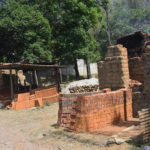



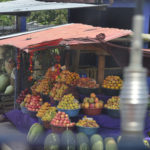
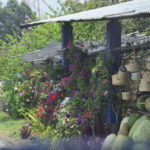

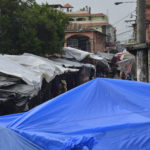

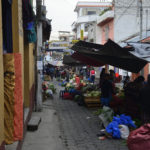

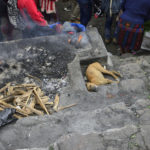

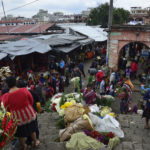



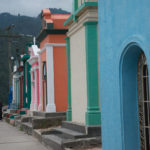


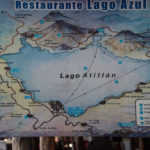






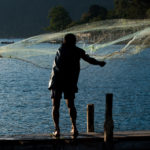



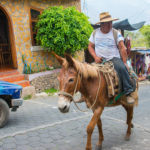



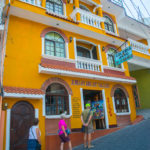










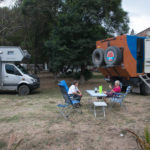
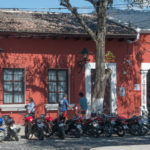
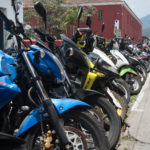
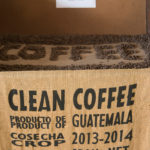
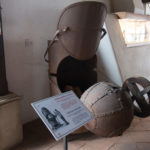







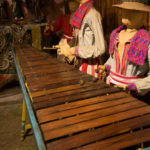
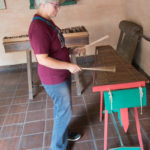







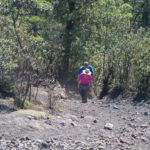




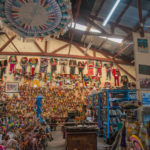







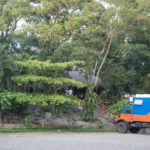

Schreibe den ersten Kommentar